Optoelectronics Market Size
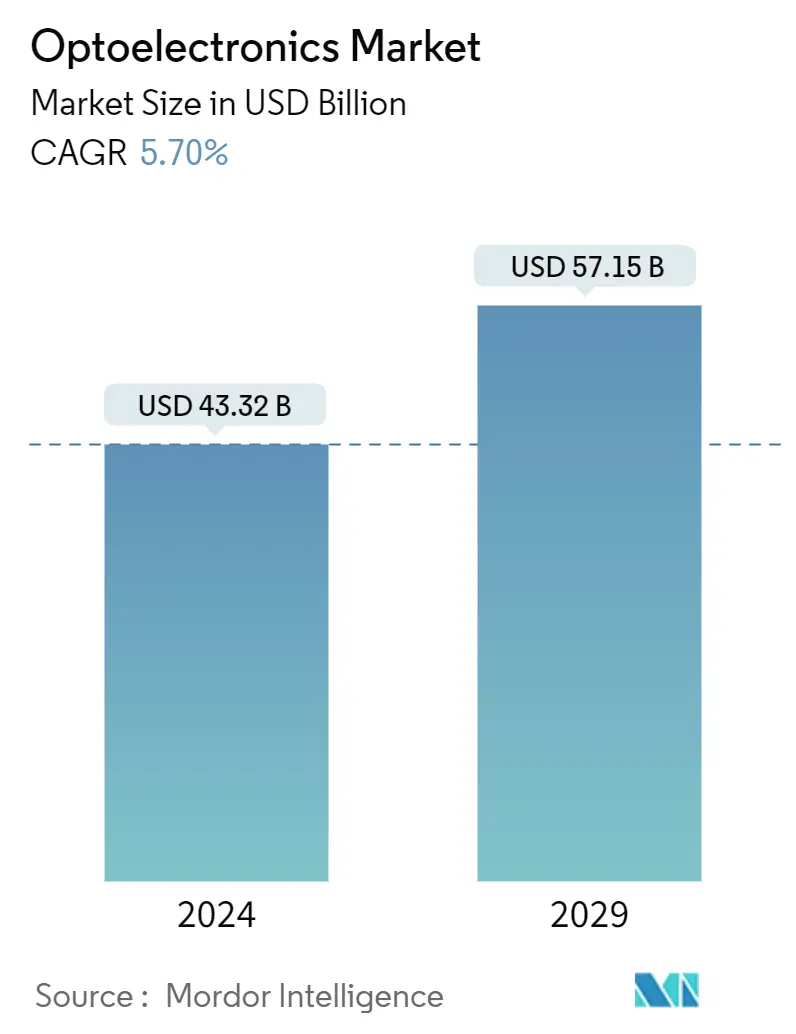
| Study Period | 2019 - 2029 |
| Market Size (2024) | USD 43.32 Billion |
| Market Size (2029) | USD 57.15 Billion |
| CAGR (2024 - 2029) | 5.70 % |
| Fastest Growing Market | Asia Pacific |
| Largest Market | Asia Pacific |
Major Players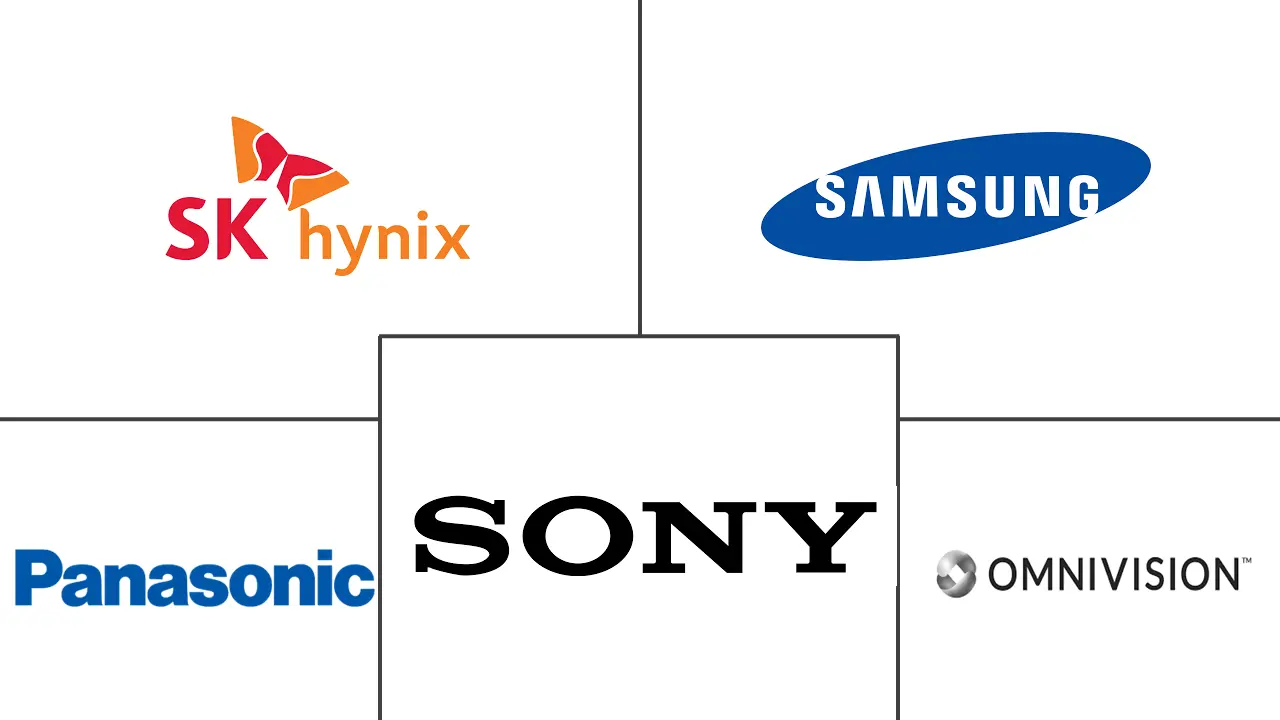
*Disclaimer: Major Players sorted in no particular order |
Optoelectronics Market Analysis
The Optoelectronics Market size is estimated at USD 43.32 billion in 2024, and is expected to reach USD 57.15 billion by 2029, growing at a CAGR of 5.70% during the forecast period (2024-2029).
- Several market drivers augment the demand for the studied market. The current market trends in optoelectronics are focused on scaling down the sizes of different devices and achieve top levels of integration in systems, such as arrays of light-emitting diodes, laser arrays, and integrated systems with other electronic elements on the same chip.
- The convergence of optical communication, optical storage, and optical imaging sectors is also driving the advancements in the optoelectronics market. Moreover, the growing demand for smart consumer electronics and next-generation technologies is anticipated to boost the adoption of optoelectronics.
- High demands for LEDs have become an industry standard for display technology in electronic devices due to an increase in demand demand for better performance and higher resolution among consumers. LEDs are used in areas like watches, computer components, medical devices, fiber optic communication, switches, household appliances, and 7-segment displays.
- Further, optoelectronic devices are used in various consumer electronic products, ranging from audiovisual technology to biomedical equipment. The increasing industrial applications of the technology and the expansion of the Li-Fi market are also contributing to the market growth. Li-Fi is a wireless communication technology that makes use of infrared and visible light spectrum for high-speed data communication. Li-Fi technology transmits data very quickly and can deliver 224 GB of data per second.
Optoelectronics Market Trends
Consumer Electronics to Witness Significant Growth
- Optoelectronics has various applications in the consumer electronics market. LEDs have revolutionized lighting systems and are used in computer components, watches, switches, household appliances, etc. Smartwatches use optoelectronic sensors, such as photodiodes, to monitor the user's heart rate. CMOS image sensors are often used in smartphones, tablets, and digital single-lens reflex (DSLR) cameras. The growing 5G network and introduction of new products with advanced technologies and features fuels the adoption of smartphones, tablets, and DSLR cameras. Also, the expanding market for mixed reality headsets is aiding the market studied.
- With the rising proliferation of 5G smartphones, many players are introducing image sensors targeted for 5G smartphones, which is contributing positively to the market. For instance, in 2022, Google launched the Pixel 6a, Pixel 7, and Pixel 7 Pro to support the 5G network in India. The Google Pixel 6a supports 19 5G bands, whereas Pixel 7 and 7 Pro support 22 5G bands.
- According to GSMA, Latin America enters the 5G era with 15 million connections expected by 2022. By 2025, 5G is predicted to account for 12% of the region's total connections, with some countries, most notably Brazil, at 20%, exceeding the regional average.
- Furthermore, according to Ericsson, the number of smartphone subscriptions in Western Europe will reach 459 million by 2028. There were approximately 440 million smartphone subscriptions in Western Europe as of 2022.
- Also, the expanding market for mixed reality headsets is aiding the market studied. For instance, in June 2023, Apple introduced Vision Pro, a mixed-reality headset with a 3D camera to help users capture spatial photos and videos in 3D.
- Currently, most AR headsets depend on one or more special imaging sensors, including time of flight (ToF) cameras, which combine a modulated IR light source with a charged coupled device (CCD) image sensor. Thus, the growing demand for these headsets significantly fuels the demand of the studied market.
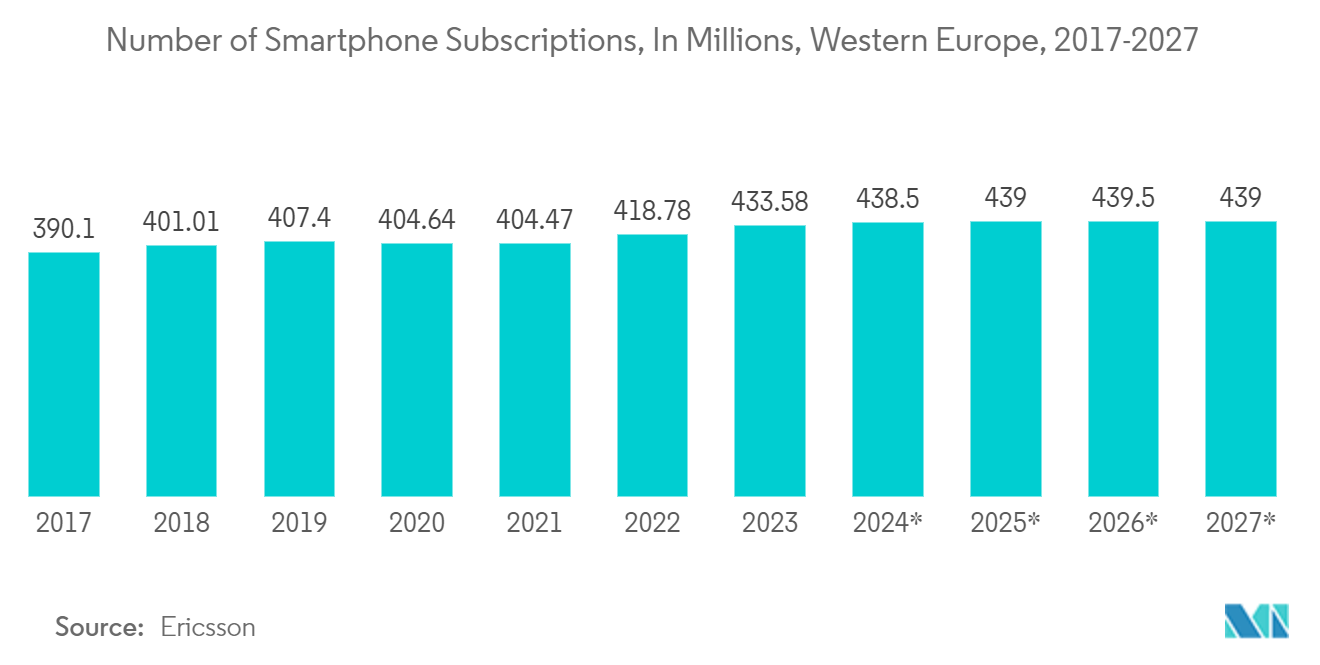
Asia-Pacific to Hold Major Share
- China is expected to experience a significant growth rate owing to its growing economy and significant share in the global electronics market. The manufacturing industry is rapidly growing in the country and is witnessing the deployment of various technologies in the manufacturing and telecommunications sectors, which is expected to aid the market's growth.
- The Japanese government is taking stringent measures to revive its industries, such as consumer electronics and automotive. Also, the government wishes to reduce the clustering of production facilities in one place to reduce production dependency on geographical constraints. The enhanced focus on the semiconductor and electronics supply chain by various global regions is expected to provide profitable opportunities for the growth of the studied market.
- India has a growing purchasing power, and the growing influence of social media is expected to drive the market for electronic goods. The increase in the number of internet users in India has witnessed a significant increase in recent years. This growth in the internet demand increased demand for faster and more efficient data transmission, driving the need for optoelectronics.
- The South Korean automotive industry is one of the major global markets for vehicle sales and production of passenger cars. It currently contributes more than 10% of all manufacturing output in the country and is experiencing growth owing to significant investments. The industry is dominated by major automakers such as the Hyundai Motor Group, which owns Hyundai, Kia, and Genesis. As a result, South Korea wields significant influence in driving automation technologies in its Automotive industry.
- According to KAMA, in 2022, South Korea exported approximately 2.3 million vehicles, comprising passenger cars and commercial vehicles, representing a 15% increase from the previous year's 2.04 million units. In addition, in 2022, around 3.76 million vehicles were manufactured in South Korea. Kia Motors produced the highest number of vehicles, accounting for 39.4% of automobile sales in South Korea. The increasing automotive demand and production in the Asia Pacific region would offer significant opportunities for developing the market studied.
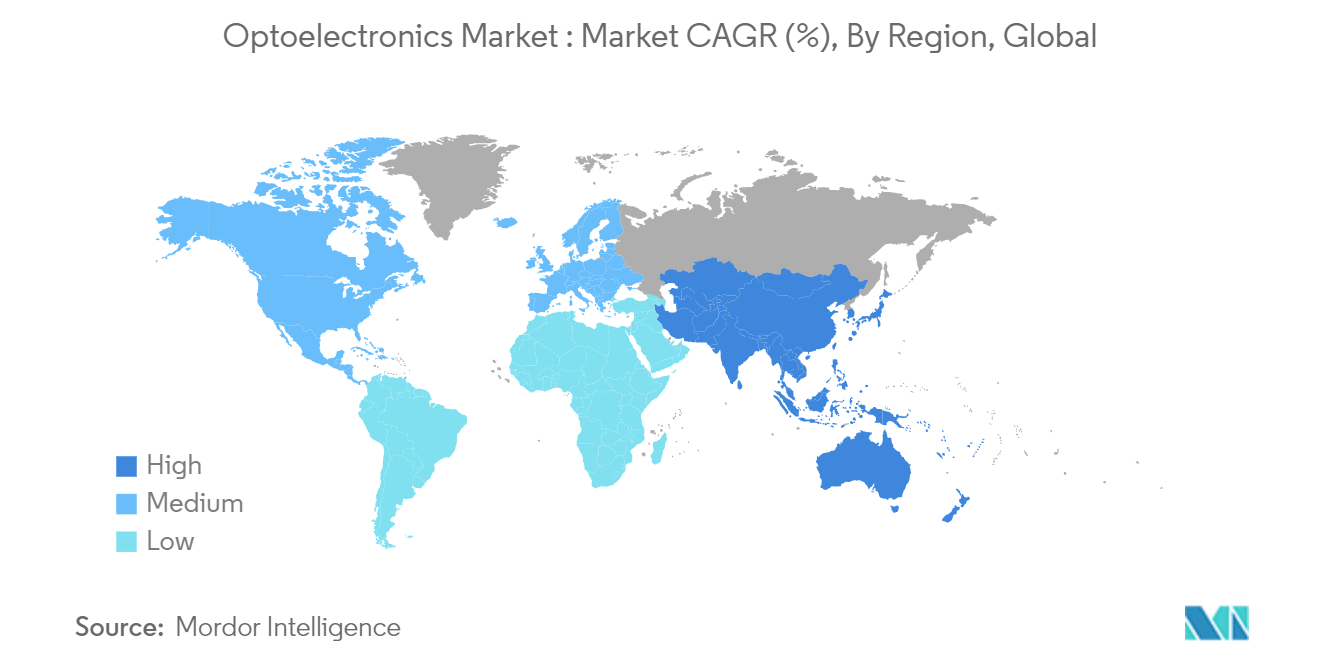
Optoelectronics Industry Overview
The optoelectronics market is semi-consolidated and is expected to remain innovation-led, with strategic alliances and frequent acquisitions adopted as the key strategies by the players to establish their presence. Meanwhile, companies SK Hynix Inc., Panasonic Corporation, Samsung Electronics, Omnivision Technologies Inc., and Sony Corporation are focusing on further developing value-added capabilities and optimizing product mix to maximize margins.
- January 2024 - Osram Licht AG introduced the ALIYOS technology, which pushes the boundaries of multi-segmented area lighting and allows individualization of light emission patterns. Characteristics like transparency, thinness, and a high freedom of design differentiate customer’s lighting solutions. An ALIYOS-based lighting unit can configure the segmented mini-LEDs to display symbols, words, images, or abstract patterns for the purposes of decoration, information, or warning. Due to the special feature of transparency, several LED foils can be placed behind each other. A three-dimensional arrangement and the full brightness control of each segment, in combination with the transparency of the modules, enable completely new lighting and animation effects.
- December 2023 - Samsung Electronics and SK Hynix joined to commercialize “On-sensor AI” technology for image sensors. They aim to elevate their image sensor technologies centered around AI and challenge the market leader, Japan’s Sony, to dominate the next-generation market. The company is currently conducting proof-of-concept research focused on facial and object recognition features, using a Computing In Memory (CIM) accelerator, a next-generation technology capable of performing multiplication and addition operations required for AI model computations.
Optoelectronics Market Leaders
-
SK Hynix Inc.
-
Panasonic Corporation
-
Samsung Electronics
-
Omnivision Technologies Inc.
-
Sony Corporation
*Disclaimer: Major Players sorted in no particular order
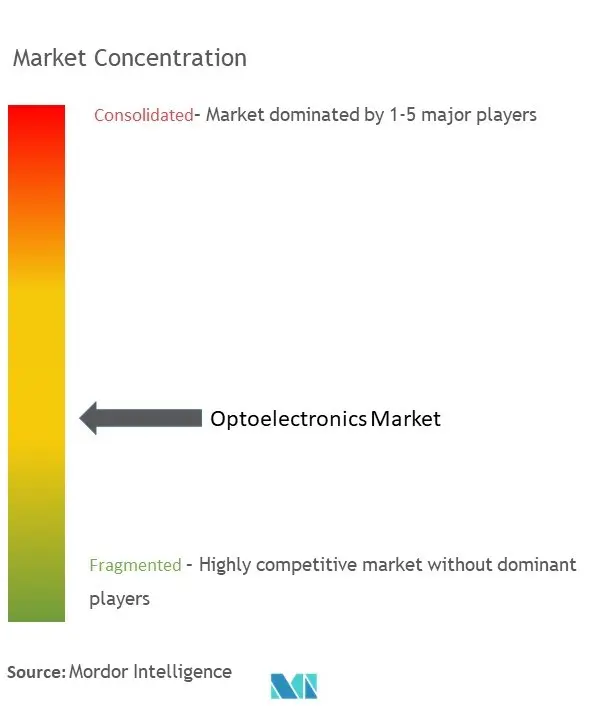
Optoelectronics Market News
- February 2024 - TSMC, Sony Semiconductor Solutions Corporation, DENSO Corporation, and Toyota Motor Corporation announced further investment into Japan Advanced Semiconductor Manufacturing, Inc. ("JASM"), TSMC's majority-owned manufacturing subsidiary in Kumamoto Prefecture, Japan, to build a second fab, which is scheduled to begin operation by the end of the 2027 calendar year. Together with JASM's first fab, which is scheduled to begin operation in 2024, the overall investment in JASM will exceed US$20 billion with strong support from the Japanese government.
- January 2024 - Osram Licht AG launched a series of sidelooker, low-power LEDs that simplify design, are easier to implement and enables the creation of a homogeneous appearance in extended light bars and other automotive rear lighting applications. By replacing toplooker LEDs with the SYNIOS P1515 sidelookers, automotive manufacturers can achieve a smooth, homogeneous appearance across the vehicle's width. With the same number of LEDs as in a top-looker-based arrangement, an RCL or turn indicator can be produced with a far thinner and simpler optical assembly.
Optoelectronics Market Report - Table of Contents
1. INTRODUCTION
- 1.1 Study Assumptions and Market Definition
- 1.2 Scope of the Study
2. RESEARCH METHODOLOGY
3. EXECUTIVE SUMMARY
4. MARKET INSIGHTS
- 4.1 Market Overview
- 4.2 Industry Value Chain Analysis
-
4.3 Industry Attractiveness - Porter's Five Forces Analysis
- 4.3.1 Bargaining Power of Suppliers
- 4.3.2 Bargaining Power of Buyers/consumers
- 4.3.3 Threat of New Entrants
- 4.3.4 Threat of Substitute Products
- 4.3.5 Intensity of Competitive Rivalry
- 4.4 Impact of COVID-19 Aftereffects and Other Macroeconomic Factors on the Market
5. MARKET DYNAMICS
-
5.1 Market Drivers
- 5.1.1 Growing demand for Smart Consumer Electronics and Next Generation Technologies
- 5.1.2 Increasing Industrial Applications of the Technology
- 5.1.3 Expansion of the Li-Fi Market
-
5.2 Market Restraints
- 5.2.1 High Manufacturing and Fabricating Costs
- 5.2.2 Challenges With Energy Loss and Heating of Optoelectronic Devices
6. MARKET SEGMENTATION
-
6.1 By Device Type
- 6.1.1 LED
- 6.1.2 Laser Diode
- 6.1.3 Image Sensors
- 6.1.4 Optocouplers
- 6.1.5 Photovoltaic cells
- 6.1.6 Others
-
6.2 By End-user Industry
- 6.2.1 Automotive
- 6.2.2 Aerospace and Defense
- 6.2.3 Consumer Electronics
- 6.2.4 Information Technology
- 6.2.5 Healthcare
- 6.2.6 Residential and Commercial
- 6.2.7 Industrial
- 6.2.8 Others
-
6.3 By Geography
- 6.3.1 North America
- 6.3.1.1 United States
- 6.3.1.2 Canada
- 6.3.2 Europe
- 6.3.2.1 United Kingdom
- 6.3.2.2 France
- 6.3.2.3 Germany
- 6.3.2.4 Spain
- 6.3.3 Asia
- 6.3.3.1 China
- 6.3.3.2 Japan
- 6.3.3.3 India
- 6.3.3.4 South Korea
- 6.3.4 Australia and New Zealand
7. COMPETITIVE LANDSCAPE
- 7.1 Vendor Market Share Analysis
-
7.2 Company Profiles*
- 7.2.1 SK Hynix Inc.
- 7.2.2 Panasonic Corporation
- 7.2.3 Samsung Electronics
- 7.2.4 Omnivision Technologies Inc.
- 7.2.5 Sony Corporation
- 7.2.6 Ams Osram AG
- 7.2.7 Signify Holding
- 7.2.8 Vishay Intertechnology Inc.
- 7.2.9 Texas Instruments Inc.
- 7.2.10 LITE-ON Technology Corporation
- 7.2.11 Rohm Company Limited
- 7.2.12 Mitsubishi Electric Corporation
- 7.2.13 Broadcom Inc.
- 7.2.14 Sharp Corporation
8. INVESTMENT ANALYSIS
9. MARKET OPPORTUNITIES AND FUTURE TRENDS
** Subject To AvailablityOptoelectronics Industry Segmentation
Optoelectronics is a sub-field of photonics that studies the application of electronic devices and systems that detect and control light.
The optoelectronics market is segmented by device type (LED, laser diode, image sensors, optocouplers, photovoltaic cells, and others), end-user industry (automotive, aerospace and defense, consumer electronics, information technology, healthcare, residential and commercial, industrial, and others) and geography (North America (United States, Canada), Europe (United Kingdom, France, Germany, Spain, Rest of Europe), Asia-Pacific(China, Japan, India, South Korea, Rest of Asia-Pacific), Rest of World)). The market size and forecasts are provided in terms of value (USD) for all the above segments.
| By Device Type | LED | |
| Laser Diode | ||
| Image Sensors | ||
| Optocouplers | ||
| Photovoltaic cells | ||
| Others | ||
| By End-user Industry | Automotive | |
| Aerospace and Defense | ||
| Consumer Electronics | ||
| Information Technology | ||
| Healthcare | ||
| Residential and Commercial | ||
| Industrial | ||
| Others | ||
| By Geography | North America | United States |
| Canada | ||
| By Geography | Europe | United Kingdom |
| France | ||
| Germany | ||
| Spain | ||
| By Geography | Asia | China |
| Japan | ||
| India | ||
| South Korea | ||
| By Geography | Australia and New Zealand |
Optoelectronics Market Research FAQs
How big is the Optoelectronics Market?
The Optoelectronics Market size is expected to reach USD 43.32 billion in 2024 and grow at a CAGR of 5.70% to reach USD 57.15 billion by 2029.
What is the current Optoelectronics Market size?
In 2024, the Optoelectronics Market size is expected to reach USD 43.32 billion.
Who are the key players in Optoelectronics Market?
SK Hynix Inc., Panasonic Corporation, Samsung Electronics, Omnivision Technologies Inc. and Sony Corporation are the major companies operating in the Optoelectronics Market.
Which is the fastest growing region in Optoelectronics Market?
Asia Pacific is estimated to grow at the highest CAGR over the forecast period (2024-2029).
Which region has the biggest share in Optoelectronics Market?
In 2024, the Asia Pacific accounts for the largest market share in Optoelectronics Market.
What years does this Optoelectronics Market cover, and what was the market size in 2023?
In 2023, the Optoelectronics Market size was estimated at USD 40.85 billion. The report covers the Optoelectronics Market historical market size for years: 2019, 2020, 2021, 2022 and 2023. The report also forecasts the Optoelectronics Market size for years: 2024, 2025, 2026, 2027, 2028 and 2029.
What are the emerging applications of Optoelectronics in different industries?
The emerging applications of Optoelectronics in different industries are a) Li-Fi technology b) Autonomous vehicles c) Advancements in medical diagnostics
Optoelectronics Industry Report
The global optoelectronics market is witnessing remarkable growth, fueled by technological advancements and broadening applications across diverse sectors. As a crucial component of photonics, optoelectronics—encompassing devices for light emission and detection—is essential in enhancing functionalities in consumer electronics through LEDs, sensors, and displays, and in the automotive industry for safety and performance. The Asia Pacific region, with its strong electronics manufacturing and automotive growth, especially in China and India, leads in market share, while North America sees significant growth from the medical, aerospace, and defense sectors. Optoelectronics companies are innovating to cater to the demand for energy-efficient and high-performance solutions across tech-savvy consumer bases and industries. With the industry evolving towards higher transmission capacities and the integration of optoelectronics in 5G technology, the market is poised for further expansion, touching various domains like data centers, automotive, and smart devices. This growth is supported by Mordor Intelligence™ Industry Reports, highlighting the market's size, share, and revenue growth, with a free report PDF download available for a comprehensive analysis.



